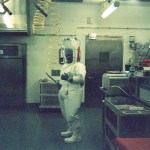infectious disease
I've been asked several times about this NY Post article on the CDC's "admission" that a sneeze could spread Ebola. The Post (which, I should note, is the least credible newspaper in New York City, for those not familiar with the paper) suggests that the CDC has changed their tune regarding the spread of Ebola.
Except, they haven't, and this is a ridiculous, trumped-up non-story, passed along not only by the Post but by others of the typical suspects like conspiracy theorist extraordinaire Mike Adams, aka "The Health Ranger" of Natural News.
Here's what the NY Post claims:
“Droplet spread…
Left to right, Granny Beck, my Grandma June, and Great-Great Grandma Bertha, circa 1961. Who knows what was on the menu that day.
My Great-Grandpa and Granny Beck were, in some ways, ahead of their time. My Grandpa’s mom and step-dad, they both went through scandalous divorces and then switched partners with another couple, Granny Orpha marrying Wade and my Grandpa’s dad Lee marrying Wade’s ex-wife, Edna. Orpha and Wade raised 5 of Orpha’s boys together, and had a daughter after the divorce/remarriage.
By the time I was born, my Granny Beck was in her 80s, and I have only vague…
The Hot Zone was first released in 1994, the year I graduated high school. Like many readers, that book and Laurie Garrett's The Coming Plague* really sparked my interest in infectious diseases. In some sense, I have those books to thank (or blame?) for my career.
But I'm still going to criticize The Hot Zone, because as a mature infectious disease epidemiologist and a science communicator in the midst of the biggest Ebola outbreak in history, The Hot Zone is now one of the banes of my existence. A recent article noted that the book is back on the bestseller list, going as high as #7 on the…
My first article at The Guardian is up: No, Ebola in Dallas does not mean you and everyone else in the US is going to get it, too.
Have a new article up at Slate. Nine months into the worst-ever Ebola outbreak, here's where we stand.
Gregg Mitman's article in the September 17th New England Journal of Medicine, "Ebola in a Stew of Fear," is unfortunately all too prescient. Dr. Mitman highlighted "the ecology of fear" in Western Africa. Fear is present on both the part of Westerners (scared of Africa's yellow fever, malaria, Ebola, its mere "different-ness"), and by native Africans (of whites' history of colonization and slavery, of medical exploitation dating back well over a century). Fear of each other.
This history of fear, the cultural legacy of decades of mistrust of both Western people and their medical…
Just before Memorial Day---the kickoff of the summer season---the Obama Administration released its agenda for upcoming regulatory action. In the worker safety world of OSHA, “regulatory action” rarely means a new regulation. Rather, it refers to a step along the long, drawn-out process to (maybe) a new rule to protect workers from occupational injuries, illnesses or deaths.
The items identified by the Labor Department suggested that OSHA planned a productive summer of 2014. Here’s what OSHA outlined for its summer tasks.
In May 2014:
Convene a meeting of small business representatives to…
I'm happy to welcome Dr. Heather Lander to the blogosphere and Twitterverse. She's a virologist who has done work with some of the world's deadliest pathogens in a high-security biosafety level 4 laboratory. This is the type of lab where one must wear "space suits" to work with organisms. You've probably seen in dramatized in various movies and TV shows (such as The Walking Dead). Heather describes what it's really like to work in one--even while pregnant.
Dr. Lander, 9 months pregnant in a BSL4 lab
TS: Can you tell readers a bit about your background and…
By the same lead author that published the pig Ebola transmission paper comes a new publication examining airborne transmission among primates. In these, Ebola did *not* spread between non-human primates (NHPs) via air. I sent an email to the PI to comment; will update the post if he responds, but in the meantime, some money quotes directly from the publication:
"One experiment reported contact free transmission between infected NHPs to one uninfected NHP although cross-contamination due to husbandry practices could not be ruled out with certainty26. Interestingly, EBOV infected swine…
Yambuku, Zaire, 1976. A new disease was spreading through the population. Patients were overcome by headaches and bloody diarrhea. The disease was spreading through entire families and wiping them out.
Eight hundred and twenty-five kilometers to the northeast, a similar epidemic was reportedly raging across the border in Maridi, Sudan. Were these outbreaks connected? Despite enormous challenges trying to navigate both the logistics of crossing a landscape of unpaved and unmarked roads, as well as the political difficulties of an attempt to enter and collect samples in an area marked by recent…
For several days now, people have been quoting The Hot Zone* at me as a realistic account of an Ebola outbreak. Just...no. I have an article up today at mic.com addressing this and some more Ebola myths: Everything you know about Ebola is wrong.
*Entertaining as hell, but very over-dramatized.
Since yesterday's post, several people have asked me on various social media outlets about the airborne nature of Ebola. Didn't I know about this paper ("Transmission of Ebola virus from pigs to non-human primates"), which clearly showed that Ebola could go airborne?
Indeed I do--I wrote about that paper two years ago, and it in no way changes my assertion that Ebola doesn't spread between people in an airborne manner.
Let me back up. The paper in question was an experimental study done in the wake of the 2008 finding of the Reston Ebola virus in pigs and a previous study looking at…
It's odd to see otherwise pretty rational folks getting nervous about the news that the American Ebola patients are being flown back to the United States for treatment. "What if Ebola gets out?" "What if it infects the doctors/pilots/nurses taking care of them?" "I don't want Ebola in the US!"
Friends, I have news for you: Ebola is *already* in the US.
Ebola is a virus with no vaccine or cure. As such, any scientist who wants to work with the live virus needs to have biosafety level 4 facilities (the highest, most secure labs in existence--abbreviated BSL4) available to them. We have a number…
In the light of the current Ebola outbreak, I thought this post from 2007 was once again highly relevant.
As another Ebola outbreak simmers in Uganda (and appears to be increasing), I recently was in touch with Zoe Young, a water and sanitation expert with Médecins Sans Frontières (MSF*, known in the US as Doctors without Borders), who was working in the Democratic Republic of Congo during the DRC Ebola outbreak earlier this fall (and blogging it!)
Regular readers know of my interest in this virus, but I'm obviously geographically removed from any…
I can hardly do Dr. William Foege justice with a short introduction. He is one of the scientists who led the global smallpox eradication efforts. He developed the concept of ring vaccination, which targeted vaccination to those individuals around a known case of smallpox. This concept really made eradication possible, as it eliminated the need for universal vaccination. Following the success of the smallpox campaign, he has worked tirelessly to increase global vaccination rates. He led the effort to provide low-cost treatments for river blindness, resulting in an…
Eleven years ago, two scientists made a bet. One scientist wagered that a new type of antimicrobial agent, called antimicrobial peptides, would not elicit resistance from bacterial populations which were treated with the drugs. Antimicrobial peptides are short proteins (typically 15-50 amino acids in length) that are often positively charged. They are also a part of our body's own innate immune system, and present in other species from bacteria to plants. It is thought that these peptides work primarily by disrupting the integrity of the bacterial cell, often by poking…
It looks like a simple piece of paper and it’s nearly as cheap, ideally costing just pennies. But despite its small size, it’s poised to make an enormous impact and potentially save thousands of lives.
It’s a new test to spot counterfeit versions of the drug artesunate, which is one of the most important drugs used to treat malaria, a mosquito-borne disease that affects hundreds of millions of people every year. Based on the science of microfluidics, researchers at Oregon State University developed an easy-to-use and inexpensive testing kit that patients and health care providers can use to…
After this post on antibiotic resistance, many of you may have seen an exchange on Twitter calling me out for being "knee-jerk" about my call to action to do something about the overuse of antibiotics. In that post, I focused on antibiotic use in agriculture, giving only brief mention to human clinical use. There are a number of reasons for this, and while I didn't discuss them extensively on Twitter, I did want to provide an overview here in order to better explain my position and concern about antibiotic use in agriculture.
How are antibiotics used in animal production?
To start, some…
It's a parent's worst nightmare. Your healthy child is suddenly ill. The doctors you've trusted to treat him are unable to do anything about it. Drugs that we've relied upon for decades are becoming increasingly useless as bacteria evolve resistance to them. New drugs are few and far between. Old drugs, shelved because of their toxic side-effects, are being brought in as last resorts--kidney failure, after all, is better than certain death.
Unfortunately, this is increasingly the state of medicine today, and people are dying from it. The World Health Organization even recently …
Guest post by Jessica Parsons.
In November 2013 my son, Finn, was diagnosed at 3 months old with Ewing Sarcoma. The news that your child has a potentially life threatening disease at the beginning of their life is something that no parent is prepared for. Despite the scary news, he has completed 9 of the 14 rounds of chemotherapy without many problems. After 6 months of relatively easy treatment and ruled "cancer free," he has overcome more than most grown adults. He has had two surgeries, ten blood transfusions and countless shots but still maintains a happy demeanor.
Every part of his…

